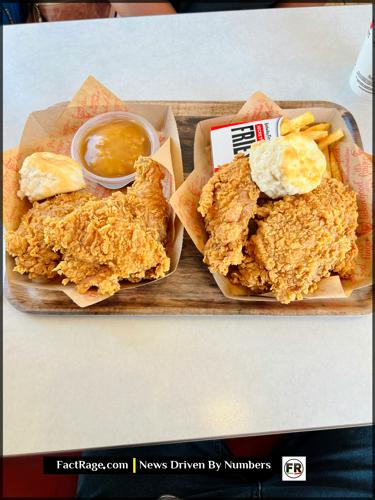FACTRAGE – As Americans celebrate National Fried Chicken Day, the story behind the beloved dish reveals a complex history of cultural fusion, economic struggle, and entrepreneurial spirit that is deeply woven into the nation’s fabric.
- Multicultural Origins – American fried chicken evolved from a blend of Scottish frying techniques and the rich seasoning and cooking methods brought to the Americas by enslaved West Africans.
- A Symbol of Resilience – Following the Civil War, fried chicken became a key tool for economic independence for Black women, who sold it to travelers and in their communities, turning a staple into a business.
- Modern Marketing – The concept of “National Fried Chicken Day” is a 20th-century marketing invention, popularized by fast-food giants to drive sales and cement the dish’s place in modern consumer culture.
Before it was the star of a marketing holiday or the centerpiece of a fast-food empire, fried chicken was a special-occasion meal with roots stretching across continents, a dish that tells a uniquely American story.
A Recipe Written by History
![]() Our most cherished foods are rarely just about flavor; they are vessels of memory, culture, and identity. Fried chicken is a powerful example, holding complex histories of migration, survival, and entrepreneurship within its familiar recipe. Understanding its journey from a special-occasion meal to a global commodity reveals something profound about how we tell our own American story, bite by bite.
Our most cherished foods are rarely just about flavor; they are vessels of memory, culture, and identity. Fried chicken is a powerful example, holding complex histories of migration, survival, and entrepreneurship within its familiar recipe. Understanding its journey from a special-occasion meal to a global commodity reveals something profound about how we tell our own American story, bite by bite.
Read On…
Here’s how a dish born from cultural fusion became a symbol of resilience and a cornerstone of American life.
What Are the Origins of American Fried Chicken?

The crisp, seasoned dish known today as fried chicken is not the product of a single culture, but a fusion of culinary traditions. Historians trace the practice of frying chicken in fat, rather than baking or boiling it, to Scottish immigrants who settled in the American South. However, the dish’s iconic flavor profile—often involving marinating and a complex blend of spices—is widely credited to the culinary ingenuity of enslaved West Africans.
For enslaved people, chickens were often one of the few types of livestock they were permitted to raise for their own families. They combined West African cooking techniques with the ingredients available to them, transforming a simple food into a flavorful and significant meal. This culinary synthesis in the kitchens of the American South created the foundation for what would become a cornerstone of Southern cuisine.
How Did Fried Chicken Become a Cultural Symbol?
Fried chicken’s journey from a regional dish to a national symbol is deeply connected to the history of Black Americans. Because chickens were relatively inexpensive to raise and the resulting dish was portable, it became a staple for Sunday dinners, community gatherings, and special celebrations.
Its role as a symbol of resilience and entrepreneurship became most prominent after the Civil War. Lacking other economic opportunities, many newly freed Black women began selling fried chicken, biscuits, and pies to travelers at train stations and from their own homes. This act of commerce provided a vital path to economic independence and established fried chicken as a food of Black self-reliance. This history is why the dish holds such a profound place in Black American culture, representing not just comfort food, but a legacy of perseverance.
Why Do We Have a “National Fried Chicken Day”?
The transition of fried chicken from a home-cooked specialty to a global commodity was supercharged in the mid-20th century. The post-war boom in car culture and franchising paved the way for entrepreneurs like Harland Sanders, whose Kentucky Fried Chicken (Yum! Brands) created a standardized recipe that could be sold across the country. This model was replicated by chains like Popeyes Louisiana Kitchen (Restaurant Brands International), which brought its own regional flavor to a mass market.
So, where did National Fried Chicken Day, celebrated on July 6th, come from? Unlike federal holidays, most “national food days” are not congressionally declared. They are typically marketing inventions created by food industry groups or specific companies to generate buzz and increase sales. While its exact origin is murky, it is widely believed that National Fried Chicken Day emerged during the fast-food boom of the 1950s as a promotional tool. Today, it functions as an annual, social-media-driven event that boosts business for everyone from small, independent restaurants to international corporate giants.
The Dish That Carries Our History
![]() The journey of fried chicken from a special-occasion meal to a fast-food staple serves as a potent reminder that our most beloved foods are living archives. They carry the stories of cultural fusion, the weight of historical struggle, and the distinct taste of resilience and entrepreneurial spirit. Ultimately, this dish tells a shared human story about how we turn simple ingredients into powerful symbols of who we are and where we come from.
The journey of fried chicken from a special-occasion meal to a fast-food staple serves as a potent reminder that our most beloved foods are living archives. They carry the stories of cultural fusion, the weight of historical struggle, and the distinct taste of resilience and entrepreneurial spirit. Ultimately, this dish tells a shared human story about how we turn simple ingredients into powerful symbols of who we are and where we come from.














